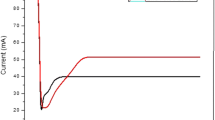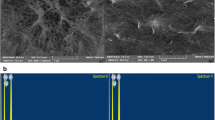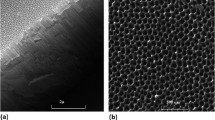Abstract
Pure and 10 % Gd doped BiFeO3 nanowires of 100-nm diameter have been synthesized by sol–gel template-assisted technique. Phase-dependent structural, dielectric and magnetic properties of pure and Gd doped BiFeO3 nanowires have been investigated. X-ray diffraction study reveals that pure BiFeO3 nanowires possess rhombohedral structure while 10 % Gd doped BiFeO3 nanowires are orthorhombic in nature. Magnetic study confirms that the value of saturation magnetization, increased with structural change via doping of Gd in host BiFeO3.
Similar content being viewed by others
Avoid common mistakes on your manuscript.
1 Introduction
Nanoscale multiferroic materials possessing smaller size and effective magneto-electric coupling, unlock exciting numerous ways for scheming future nano-electronic and spintronics devices [1, 2]. As per the demand of future technology, multifunctional oxide nanostructures can play an important role in fulfilling the future demands. Among the various kinds of nanostructures, particularly nanowires having one dimensional characteristics are the potential candidates for future nano-electronic devices.
Because, ferroelectricity and ferromagnetism (antiferromagnetism) tend to be mutually exclusive [3], only a limited multiferroic materials exist having both ferroelectricity and ferromagnetism (antiferromagnetism) simultaneously. BiFeO3 is one of the mostly studied materials [4] among the limited multiferroic materials having ferroelectric curie temperature (TC) of 830 °C and an antiferromagnetic (AFM) neel temperature (TN) of 370 °C. In BiFeO3 the weak ferromagnetism is caused by residual moment from the canted Fe3+ spin structure while the ferroelectricity is induced by the stereo-chemically active 6s2 lone pair of Bi3+. The lattice distortion of BiFeO3 induced the coupling between magnetic and electric behaviors, when an electric field or a magnetic field is applied [5–7]. It is reported that the magnetism and ferroelectricity in BiFeO3 can be enhanced by replacing Bi site with rare-earth [8–11] or substituting Fe site with transition-metal and rare-earth [12–15].
Prasanthi et al. reported surface enhanced strong visible photoluminescence from sol–gel synthesized one-dimensional multiferroic BiFeO3 nanostructures [16]. Cai et al. [17] described the ferroelectric and dielectric properties of Bi3.15Nd0.85Ti3O12 nanotubes synthesized using anodic aluminum oxide (AAO) template. Liu et al. [18] reported the spin glass transition below the freezing temperature of 55 K in BiFeO3 nanowires synthesized using improved hydrothermal method. Joshi et al. [19] reported Microwave synthesis of single-crystalline perovskite BiFeO3 nanocubes for photoelectrode and photocatalytic applications. Gao et al. [20] reported the synthesis of BiFeO3 nanowires through AAO template. They also reported weak ferromagnetism at room temperature and superparamagnetism at low temperature in BiFeO3 nanowires, different from the antiferromagnetic order in bulk BiFeO3, reflecting the important size effects on the magnetic ordering of BiFeO3. Jing et al. [21] reported the coexistence of ferroelectric and ferromagnetic ordering at room temperature in the BiFeO3 nanotubes synthesized using sol–gel AAO template method.
The main intention of the present work is to improve the enhanced magnetic properties in BiFeO3 nanowires. Appropriate magnetic ion doping may induce inter defect coupling [22, 23] for enhanced ferromagnetism. Gd is a promising dopant [24] for BiFeO3 multiferroics system for realizing improved ferromagnetism. In the present work, we report the synthesis of Gd doped BiFeO3 nanowires using sol–gel template assisted method and their structural, dielectric and magnetic properties.
2 Experimental details
Gd doped BiFeO3 nanowires were synthesized by the sol–gel template assisted technique. All the reagents in the experiments were of analytic grade and used without further purification. Fe(NO3)3·9H2O, Bi(NO3)3·5H2O and Gd(NO3)2·6H2O were first dissolved in 2-methoxyethanol for 45 min by means of ultrasonic cleaner. Solution was then heated at magnetic stirrer heater at 70 °C with constant stirring for 4 h. The sols were aged for 24 h at room temperature. The commercially available anodic aluminum oxide (AAO) templates purchased from Whatman, UK, having average pore diameter, 100 nm, and pore density, 109 cm−2 have been used. AAO templates were put in the as prepared sol for 24 h. Then AAO template filled with sol were calcined at 500 °C for 1.5 h and 750 °C for 30 min.
X-Ray diffraction data was collected using a Panalytical XPERT–PRO diffractometer with Cu K α radiation at a step of 0.02° in the range 2θ = 20°–80°. Scanning electron microscopic (SEM) measurements were carried out by JEOL 6100. Dielectric constant and dielectric loss were performed using an Agilent precision impedance analyzer over the frequency range from 20 to 2 MHz. For dielectric measurements, both surfaces of filled AAO template were polished with silver paste to make electrodes. Quantum design vibrating sample magnetometer (VSM) was used for the magnetic characterization of pure and Gd doped BiFeO3 nanowires.
3 Results and discussion
Figure 1a depicts the XRD patterns of pure and 10 % Gd doped BiFeO3 nanowires at room temperature. It is clearly evident from the XRD patterns that the structure of pure BiFeO3 samples has rhombohedral symmetry, which is in agreement with the JCPDS card No. 86-1518. BiFeO3 nanowires with 10 % Gd doping illustrate orthorhombic structure. Usually pure BiFeO3 (x = 0) is noncentrosymmetric rhombohedral structure having space group R3c and parent GdFeO3 (x = 1) is centrosymmetric orthorhombic structure having space group Pnma. Due to metastable nature of BiFeO3 and its chemical kinetics of formation it is always coupled with some impurity phases as Bi25FeO40 and Bi2Fe4O9 [25]. It is clearly depicted that (104) and (110) diffraction peaks in the vicinity of 2θ = 32.1° are separated in pure BiFeO3 nanowires, which get merged to a single broad (020) peak and also has a tendency to shift toward higher 2θ value when 10 % Gd ion concentration is doped in BiFeO3 (Fig. 1b). Diffraction peak of (006) occurred at 2θ = 38.85° has been credited as the indicator of the rhombohedral structure in pure BiFeO3. This (006) peak vanishes in 10 % Gd doped BiFeO3 nanowires. Disappearance of (006) peak signifies the structural phase conversion from rhombohedral to orthorhombic phase [26, 27]. One more peak indexing to (121) in the region of 2θ = 38°–40° related to orthorhombic structure is observed along with disappearance of (006) and (202) peaks is also an indication of the structural conversion from its original rhombohedral structure to orthorhombic. The phase transition from rhombohedral to orthorhombic structure is ascribed to the structural deformation resulting from the inclusion of Gd3+ ions into the BiFeO3 lattice, for the reason [28] that the ionic radius of Gd3+ is smaller than that of Bi3+. Figure 2 shows SEM image of Gd doped BiFeO3 nanowires. It is clear from Fig. 2 that the nanowires are dense and possess diameter 100 nm.
Figure 3a, b, show the frequency dependence of dielectric constant and dielectric loss in pure and 10 % Gd doped BiFeO3 nanowires at room temperature, respectively. Both dielectric constant and dielectric loss decreases with increase in frequency which may be attributed due to the incapability of the electric dipoles to be in pace with the frequency of applied electric field [29, 30]. It is observed from Fig. 3a, that the values of dielectric constant were around 379 and 533 for pure and 10 % Gd doped BiFeO3 nanowires, respectively at 1 kHz. Both samples show dielectric dispersion. The value of dielectric constant is high at low frequencies; it decreases quickly up to 10 kHz and shows a stable value afterwards. The observation of enhanced dielectric constant for 10 % Gd doped BiFeO3 nanowires may be due to the development of large dipole moment due to structural deformation from rhombohedral to orthorhombic.
The two sources of polarization i.e. dipolar and interfacial polarization play major role in dielectric measurement, since in the high frequency range, the value of dielectric constant becomes stable. Dipolar polarization or orientational polarization contributes to the dielectric properties in the range 103–106 Hz (sub infra-red) [31]. The interfacial polarization takes place when mobile charge carriers are obstructed by a physical barrier. As a result, the charges pile up at the barrier creates a localized polarization. Interfacial polarization occurs in the low frequency range (102 Hz). As pure and Gd doped BiFeO3 nanowires are prepared by sol–gel template assisted technique, the complex dielectric behavior may be contributed by dipolar and interfacial polarization including localized defects. The dielectric loss for the pure and Gd doped BiFeO3 nanowires as shown in Fig. 3b, exhibit similar behaviour as observed for dielectric constant (Fig. 3a).
Magnetization versus magnetic field (M–H) loops for pure and 10 % Gd doped BiFeO3 nanowires are shown in fig. 4. The M–H loops of nanowires were measured at room temperature, depicting the saturation magnetization (Ms) of pure and Gd doped BiFeO3 nanowires. Different reasons may be possible for the high value of saturation magnetization and ferromagnetic character of 10 % Gd doped BiFeO3 nanowires. BiFeO3 exhibits distorted perovskite structure with space group R3c. Gd doping (magnetically active ions) having radius smaller than that of Bi, leads to the structural distortion resulting in the destruction of spiral spin cycloid and leads to termination of the weak ferromagnetism with the release of locked magnetization [26]. The large effective magnetic moment of Gd coupled with Fe ions may be another reason for enhanced magnetization. It may also predict that more incorporation of Gd (10 %) may induce defects in the BiFeO3 main matrix, which in turn stimulates defect driven ferromagnetism in Gd doped BiFeO3 nanowires [32].
4 Conclusions
10 % Gd doping in BiFeO3 nanowires, transforms the original rhombohedral (R3c) structure of BiFeO3 into orthorhombic (Pnma) structure. Magnetic study depicts that both pure and 10 % Gd doped BiFeO3 nanowires possess ferromagnetic behaviour, and saturation magnetization increases with Gd-doping. Doping of Gd also suppresses the spiral spin structure in BiFeO3; as a result saturation magnetization gets enhanced. Pure and 10 % Gd doped nanowires possess frequency dependent dielectric constant, which decreases with increase in frequency and remains almost constant at higher frequencies.
References
W. Eerenstein, N.D. Mathur, J.F. Scott, Nature 442, 759 (2006)
R. Ramesh, N.A. Spaldin, Nat. Mater. 6, 21 (2007)
K.F. Wang, J.M. Liu, Z.F. Ren, Adv. Phys. 58, 321 (2009)
G. Catalan, J.F. Scott, Adv. Mater. 21, 1 (2009)
J. Wang, J.B. Neaton, H. Zheng, V. Nagarajan, S.B. Ogale, B. Liu, D. Viehland, V. Vaithyanathan, D.G. Schlom, U.V. Waghmare, N.A. Spaldin, K.M. Rabe, M. Wuttig, R. Ramesh, Science 299, 1719 (2003)
J. Li, J. Wang, M. Wuttig, R. Ramesh, N. Wang, B. Ruette, A.P. Pyatakov, A.K. Zvezdin, D. Viehland, Appl. Phys. Lett. 84, 5261 (2004)
R.R. Das, D.M. Kim, S.H. Baek, C.B. Eom, F. Zavaliche, S.Y. Yang, R. Ramesh, Y.B. Chen, X.Q. Pan, X. Ke, M.S. Rzchowski, S.K. Streiffer, Appl. Phys. Lett. 88, 242904 (2006)
G.S. Lotey, N.K. Verma, J. Nanopart. Res. 14, 742 (2012)
A. Gautam, K. Singh, K. Sen, R.K. Kotnala, M. Singh, Mater. Lett. 65, 591 (2011)
G.D. Hu, S.H. Fan, C.H. Yang, W.B. Wu, Appl. Phys. Lett. 92, 192905 (2008)
V.R. Reddy, D. Kothari, A. Gupta, S.M. Gupta, Appl. Phys. Lett. 94, 082505 (2009)
M. Kumar, K.L. Yadav, J. Phys. Condens Matter 18, L503 (2006)
F.G. Chang, N. Zhang, F. Yang, S.X. Wang, G.L. Song, J. Phys. D Appl. Phys. 40, 7799 (2007)
M. Kumar, K.L. Yadav, J. Appl. Phys. 100, 074111 (2006)
M. Azuma, H. Kanda, A.A. Belik, Y. Shimakawa, M. Takano, J. Magn. Magn. Mater. 310, 1177 (2007)
K. Prashanthi, G. Thakur, T. Thundat, Surf. Sci. 606, L83 (2012)
W. Cai, X. Lu, H. Bo, Y. Kan, Y. Weng, L. Zhang, X. Wu, F. Huang, L.M. Eng, J. Zhu, F. Yan, J. Appl. Phys. 110, 052004 (2011)
B. Liu, B. Hu, Z. Du, Chem. Commun. 47, 8166 (2011)
U.A. Joshi, J.S. Jang, P.H. Borse, J.S. Lee, Appl. Phys. Lett. 92, 242106 (2008)
F. Gao, Y. Yuan, K.F. Wang, X.Y. Chen, F. Chen, J.-M. Liu, Z.F. Ren, Appl. Phys. Lett. 89, 102506 (2006)
Wang Jing, Li Mei-Ya, Liu Xiao-Lian, Pei Ling, Liu Jun, Yu. Ben-Fang, Zhao Xing-Zhong, Chin. Phys. Lett. 26, 117301 (2009)
V.A. Khomchenko, D.A. Kiselev, I.K. Bdikin, V.V. Shvartsman, P. Borisov, W. Kleemann, J.M. Vieira, A.L. Kholkin, Appl. Phys. Lett. 93, 262905 (2008)
C.D. Pemmaraju, S. Sanvito, Phys. Rev. Lett. 94, 217205 (2005)
S. Dhar, O. Brandt, M. Ramsteiner, V.F. Sapega, K.H. Ploog, Phys. Rev. Lett. 94, 037205 (2005)
S.K. Pradhan, J. Das, P.P. Rout, V.R. Mohanta, S.K. Das, S. Samantray, D.R. Sahu, J.-L. Huang, S. Verma, B.K. Roul, J. Phys. Chem. Solids 71, 1557 (2010)
S.K. Pradhan, B.K. Roul, J. Phys. Chem. Solids. 72, 1180 (2011)
B.K. Roul, J. Supercond. 14, 529 (2001)
P. Uniyal, K.L. Yadav, Mater. Lett. 62, 2858 (2008)
P. Uniyal, K.L. Yadav, J. Alloys Compd. 492, 406 (2010)
I. Sosnowska, T. Peterlin-Neumaier, E. Streichele, J. Phys. C: Solid State Phys. 15, 4835 (1982)
S. Cavdar, H. Koralay, N. Tugluoglu, A. Gunen, Supercond. Sci. Technol. 18, 1204 (2005)
S.K. Pradhan, J. Das, P.P. Rout, S.K. Das, D.K. Mishra, D.R. Sahu, A.K. Pradhan, V.V. Srinivasu, B.B. Nayak, S. Verma, B.K. Roul, J Mag. Mag. Mater. 322, 3614 (2010)
Acknowledgments
This work is supported by Department of Science and Technology (DST), Govt. of India under Nano Mission scheme (sanction order no. SR/NM/NS-84/2008).
Author information
Authors and Affiliations
Corresponding author
Rights and permissions
About this article
Cite this article
Kumar, S. Structural, dielectric and magnetic characterization of large scale template synthesized Gd doped BiFeO3 nanowires. J Mater Sci: Mater Electron 24, 2112–2115 (2013). https://doi.org/10.1007/s10854-013-1066-9
Received:
Accepted:
Published:
Issue Date:
DOI: https://doi.org/10.1007/s10854-013-1066-9








